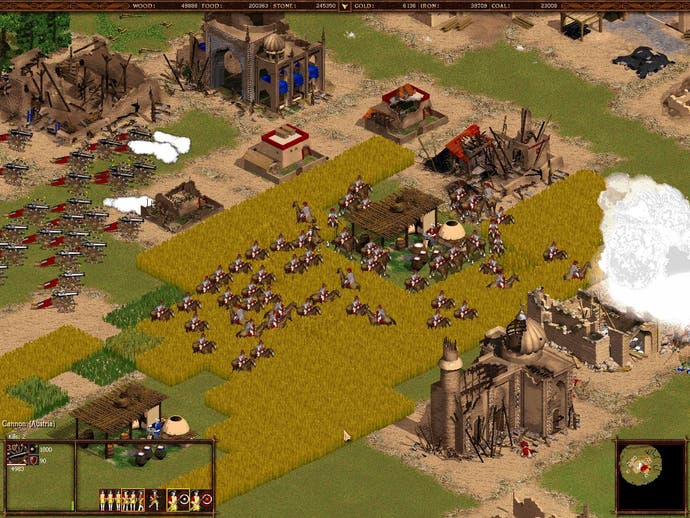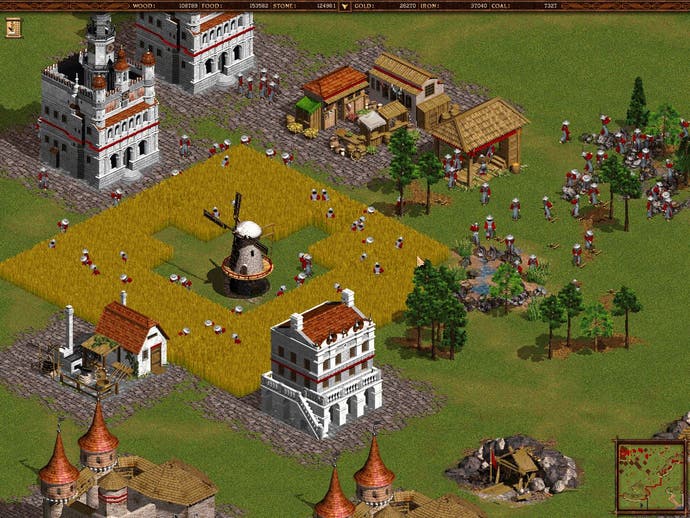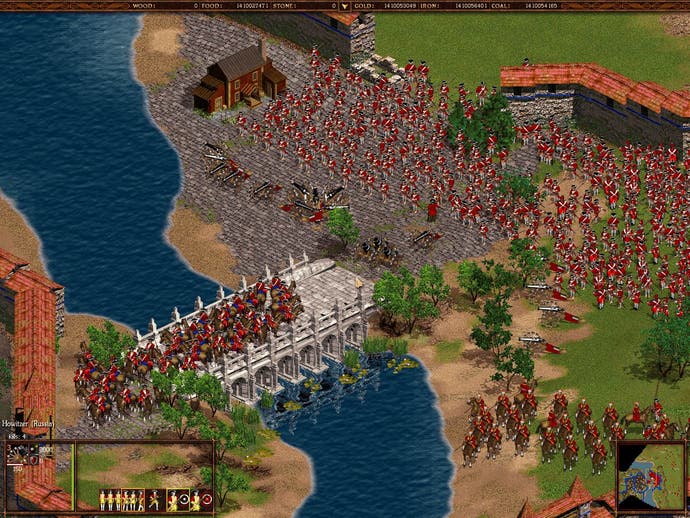Cossacks : European Wars
Review - CDV brings us historical real-time strategy on an epic scale
- CDVSystem Requirements - Pentium 233 or equivalent 32Mb RAM 400Mb hard drive space DirectX graphics card

Epic
At first sight Cossacks looks like a straightforward Age of Empires clone - a historical real-time strategy game featuring all the familiar base building, gold mining, stone quarrying and wood chopping of Ensemble's games, but set in the 17th and 18th centuries.
What sets Cossacks apart is its epic scope. There is a sprawling tech tree to research with literally hundreds of upgrades and technologies to discover, ranging from improved armour and weapons for your various troop types to reconnaissance balloons. There are no less than 16 seperate nationalities to play as, ranging from England and France to Saxony and the Ukraine, many of them with their own unique units and graphics. Perhaps most impressive though is the ability to have anything up to eight thousand soldiers in a single battle without any serious slow downs.
Needless to say this can make things pretty hectic at times, and luckily the mouse-driven interface is simplicity itself, with all the niceties you would expect from a modern real-time strategy game. Troops can be set up to follow a series of waypoints, grouped together into hotkey-selectable armies, and told to hold their fire or attack everything they see on their way to their destination. You can even assign them to line, column or square formations, although unfortunately these are less useful than they should be as they are rather clumsy to manoeuvre. And whereas in a hardcore wargame being in a formation would give you some sort of defensive or morale bonus, in Cossacks it doesn't seem to give any obvious advantages, apart from looking pretty in screenshots.

Campaign
For those of you new to the genre or wanting to brush up on the slight control differences between this and similar titles, there is an entire tutorial campaign to ease you into the game and introduce all the basic concepts. In addition to the tutorial there are four "real" campaigns, varying from cleaning pirates out of the Caribbean to battling your way across France or Eastern Europe. All of this is (rather loosely) based on real European wars and battles.
These campaigns are at times incredibly difficult, often limiting the units you can use or even sending you into battle with no way of replenishing your lost troops, and then throwing hordes of enemies at your ill-prepared and poorly balanced army. Some missions are virtually impossible to complete, and will require you to work out the right approach or even to rely on exploiting any weaknesses you can find in the AI.
Sadly these are all too common. Your opponent is surprisingly passive unless it has been pre-scripted to attack you, and its offensives are often rather piecemeal. You can usually find small groups of enemy troops standing around doing nothing, and sometimes they will continue to do nothing as you bombard them from a safe distance with artillery or small arms fire, especially if they are waiting for a trigger or timer in the mission script. They are also easily tricked by simply opening and closing your city gates - as the gates open the enemy rushes towards you, only to stop dead or withdraw as you close them again. Well-placed cannons, defensive towers or musketeers can gradually whittle away vastly superior forces in this way, and in one of the campaign missions you are actually advised to exploit this by an in-game message!

Uphill Battle
If the campaigns are mostly too hard, the ten stand-alone scenarios are too easy. At first they will prove a challenge, but as you start to work out the weaknesses of the AI, which troops to use in which situations and what order to construct buildings and research techologies in, you will soon find that defeating the computer is more a case of persistence than skill. On a level playing field the AI simply isn't up to the job, and sadly this also makes random skirmish games rather unrewarding for more experienced players.
Overall the game seems to be fairly well balanced, using a complicated kind of rock, paper and scissors relationship whereby every troop type has its own strengths and vulnerabilities. Defensive towers are devestating, especially against large formations of infantry, but cannons and mortars have a longer firing range and can destroy them without getting close enough for the tower to respond. Cannons must be escorted by other soldiers though, as fast-moving enemy cavalry could easily capture any unprotected artillery. And so on. In fact the only good all-round unit is the grenadier, which can use its rifle at medium range, defend itself with a bayonet in melee, and use grenades to demolish walls and towers at close range.
In another nod to realism, terrain has a much greater effect on gameplay in Cossacks than in most other real-time strategy games. Walking uphill slows an army down and units on top of a plateau or hill will have a slightly higher firing range than those below, giving you more opportunity to annihilate any attacking infantry or cavalry with musketeers and artillery. This means that occupying the high ground is a highly effective strategy, and when combined with towers on top of nearby hills and short lengths of wall to link highland areas and prevent your enemy from getting on to them, this can add a lot to your defences.

Europe At War
Where these kinds of strategies really come into their own is the multiplayer mode, which supports up to seven players in any single battle. Getting into a game is easy thanks to a built-in server browser and chat lobby, and the random map generator used for the vast majority of internet games (as well as AI skirmishes) is highly customisable, allowing you to decide everything from the general layout of the battlefield (islands, continental, in-land sea etc) to how rugged the terrain is and how common resources are.
There are also several multiplayer-only historical battles which you can re-enact online, with two armies fighting it out to achieve their objectives in a preset map. Unfortunately very few people seem to be willing to play these, and the sheer number of units which you start with in some of them can prove a bit overwhelming.
Overall the multiplayer mode is probably the most enjoyable way of playing the game, although the sheer scale of the game can make battles a little longwinded. Most players will ask for at least half an hour of "peace time" at the beginning of every match, during which you will not attack each other. Your first few battles will probably end just minutes after this truce ends, as the enemy overwhelms your pathetic defences. Once you know what you are doing and can put up more of a fight though, battles can sometimes last anything up to three or four hours, with anything up to an hour of peace time at the beginning. If you or one of the other players is disconnected half way through a battle due to lag (something which every real-time strategy game suffers from to some extent) it can obviously be rather frustrating.
Conclusion
Cossacks is an excellent strategy game which is sadly somewhat marred by its overly difficult campaigns and unimpressive enemy AI. The single battle and random skirmish modes should prove entertaining for less experienced gamers though, and the campaigns will certainly challenge even real-time strategy veterans, even if they were a bit too hard at times for my tastes.
But multiplayer is the real strength of the game, and is well worth a try if you have a decent internet connection and don't mind being humiliated in your first few battles by the Germans, who have had a few months head start on us with the game. You will also no doubt be entertained by such great examples of Deutschlish as "er hat getimed out" and "ich bin ein mega newbie" in the chat rooms...

